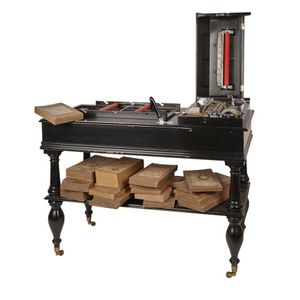Regency Drop Side Sofa Table with Brass Stringing and Carved Support
You must be a subscriber, and be logged in to view price and dealer details.
Subscribe Now to view actual auction price for this item
When you subscribe, you have the option of setting the currency in which to display prices to $Au, $US, $NZ or Stg.
- Stringing - Fine inlaid lines, in contrasting colour to the carcase timber, found mainly on furniture made in the styles of the later 18th and early 19th centuries. Stringing, which may be of satinwood, pine, ebony, horn, brass or occasionally ivory, is found principally on drawer fronts, around the outer edges of usually tapered legs and French bracket feet, around the edges of inlaid panels and between the joint of the cross banding and carcase timber on table tops, chests of drawers, cabinets etc. The effect is to emphasize the line of the piece and add to the impression of lightness and elegance. Stringing also occurs in Sheraton-revival-style furniture of the later 19th and early 20th centuries.
- Apron - A decorative wooden panel that sits underneath the top surface of a table or chair, and unites the top of the piece with the legs, running at right angles to the underside. On carcase furniture such as a chest or wardrobe, the apron sits below the drawers or doors and attaches to the legs.
On carcase furniture without legs the panel under the drawers or doors sits on the floor and is termed a plinth.
An apron can provide a decorative touch to an otherwise unadorned piece of furniture and at the same time provide structural support and strength. They can be carved or pierced and quite elaborate. - Regency Period - The Regency period in English furniture design refers to the period when King George III, was declared unfit to rule in 1811, and his son ruled as proxy as Prince Regent, until 1820, and then, after the death of his father as George IV until his death in 1830. The Regency period was preceded by the Georgian period (George I, George II, and George III: 1714 - 1811), and was followed by the William IV period, which only lasted until 1837 when William IV died as was succeeded by Queen Victoria.
This item has been included into following indexes:
-
tables, purpose or type
- drop-leaf / drop side 388
- sofa 140
Visually similar items

A William IV rosewood card table, the top opens to reveal green baize-raised on a turned column with acanthus leaf decoration, quatrefoil base with lion paw feet. 91 cm x 45 cm x 75 cm

Early Victorian mahogany twin pedestal extension table, circa 1840, quatrefoil bases supporting hexagonal columns, lacking runner supports for leaves, two extension leaves (not shown in image) 80 cm each, 73 cm high, 140 cm long (without leaves) 300 cm (ex

A Regency rectangular rosewood card table, 76 cm high, 92 cm wide, 45 cm deep

An Edwardian 'Racca Piano Melodica' with card books C. 1910, black lacquer with turned legs and bookshelf, brass castors, working. Dimensions 80 cm x 10 cm x 4 cm.
